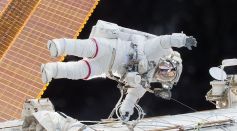Tags: NASA

NASA Partners With SpaceX to Launch Elements of Lunar Gateway to Moon Outpost
NASA Engaging Scientists, Engineers to Determine Ice Water Deposits on Mars
Where On Earth Did NASA Plant The Moon Trees From Apollo 14 Mission?

NASA Found Missing Golf Ball 50 Years Since Apollo 14 Crew Played on the Moon

NASA Partners With SpaceX for $99M-Worth of Mission Exploring Origins of the Universe
Did NASA Just See 'Pulsar SXP 1062' Hidden In Supernova Remnant?
NASA and CSA Will Give $500,000 To The Best Idea of Food Production In Space

Scientists Shares Stunning Image of the Moon Showing Apollo 15 Landing Site

NASA Spacewalkers Finally Completed Four-Year-Long Power Upgrade for ISS

Is NASA Still Searching For Artemis Lunar Base Camp Despite Delays on Moon Lander Contracts?

NASA Parker Solar Probe Spacecraft Will Finally Go the Sun To Take a Photo of Six Planets

Space Shuttle Challenger 35 Years After Explosion: Lessons Learned From the Fatal Disaster

NASA Perseverance Rover's Epic Journey To Mars: Will It Defy 7 Minutes of Terror?

TRAPPIST-1 Planets May Have Unusual Similar Compositions, NASA Says

NASA 's Hubble Space Telescope Shares Surprising Photo of Lost Galaxy

NASA Astronauts Prepare For Two Upcoming Spacewalks This Year

NASA InSight 'Mole' Ends Digging on Surface of Mars After Failed Attempts

NASA Hubble Space Telescope Shares Supernova Remains Spotted 1700 Years Ago
NASA’s Perseverance Rover Set to Land on Mars in Less Than a Month
NASA Detects Stunning Structures Behind Solar Winds
Most Popular

Can the World Run Out of Water? Water Scarcity Science and Climate Impact Explained

Solar Maximum 2026: Inside the Sunspot Cycle and Solar Activity Forecast Astronomers Are Watching

Volcanic Warning Signs: How Magma Movement Reveals Eruption Prediction Clues for Geologists

Could Technology Prevent Natural Disasters? How Disaster Prediction and Early Warning Systems Could Save Lives




